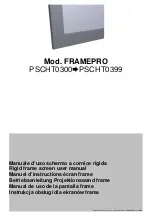
GLOSSARY
Bow >
A horizontal curve in the center of the image, and/or a vertical curve across an image.
Brightness
>
Brightness in projection usually describes the amount of light emitted from a surface such
as a screen. Brightness is measured in lumens, foot-lumens, foot-candles, or lux.
Candela or Candle
>
The intensity of light is measured in candelas.
Channel
>
A 2-digit number with user-assigned source input information. This information includes
a physical input (switcher, slot), a setup memory (input or recall), and a name or
description. Assignments are made through the Channel List.
Channel List
>
A list of up to 99 channels (explained above) which may be created, edited, or deleted by
the user. The Channel List feature provides an alternative, and sometimes easier, way to
select sources and their setups.
Color Shift
>
The change in the tint of a white field across an image.
Color Temperature
>
This term refers to the coloration (reddish, white, bluish, etc.) of a white image. (It does
not refer to the brightness of a white image.) The Kelvin (K) temperature scale is used to
measure color temperature.
Color Temperature
Uniformity
>
The accuracy of color temperature at any location.
Composite Video
>
This term refers to the output of video tape players and some computers.
Synchronization, luminance, and color signals are combined on one output cable.
Contrast
(ratio)
>
The ratio of brightness of the brightest possible area to the darkest possible area of an
image.
Convergence
>
The alignment of the projected red, green and blue images on the projection screen.
Current Setup Memory
>
The setup memory, which is currently being used to display a given source's
Memory
image.
Curved Screen
>
A projection screen, which is curved to improve screen gain. Curved screens usually have
screen gains which are greater than 1 but viewing angles much less than 180 degrees.
Decoder
>
A device that converts NTSC, PAL, PAL M, PAL N, PAL 60, SECAM or NTSC 4.43
video to RGB video
(
Multi-standard Decoder).
Diffused Screen
>
A type of rear-projection screen, which spreads the light striking it. Screen gain is less
than 1 but audience viewing angles are increased.
A-2
Summary of Contents for Model 9
Page 1: ......
Page 44: ...INSTALLATION SETUP Figure 2 29 ACON Installation Examples 2 38...
Page 104: ...Physical Dimensions 5 5...
Page 105: ...5 6...
Page 113: ...A p p e n d i x B B 1...
Page 114: ...B 2...
Page 115: ...C 1...
Page 116: ...C 2...
Page 117: ...D 1...
Page 118: ...D 2...
Page 119: ...E 1...
Page 120: ...F 1...
Page 121: ...F 2...
Page 122: ...F 3...
Page 123: ...F 4...
Page 124: ...F 5...
Page 125: ...F 6...
Page 126: ...F 7...
Page 127: ...F 8...
Page 128: ...F 9...
Page 129: ...F 10...
Page 130: ...G 1...
Page 131: ...Index 1...
Page 132: ...Index 2...
















































